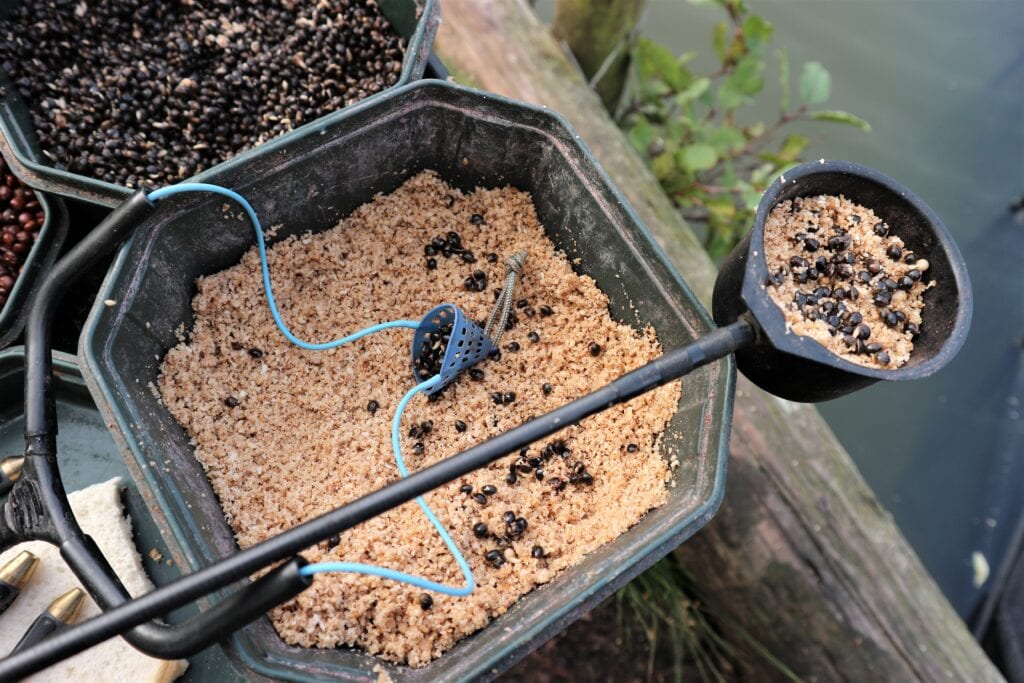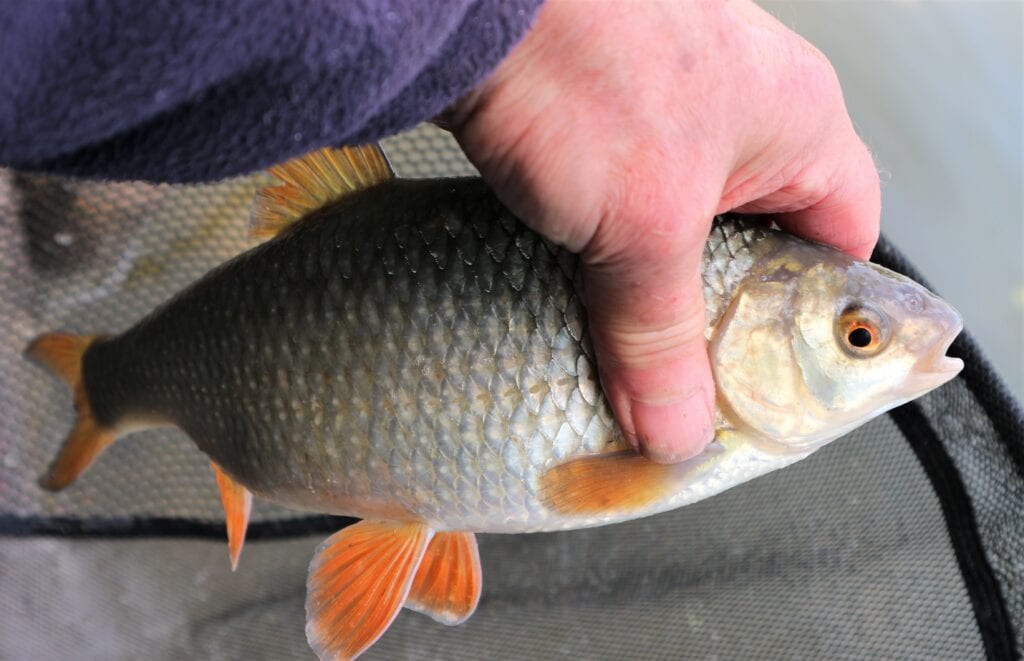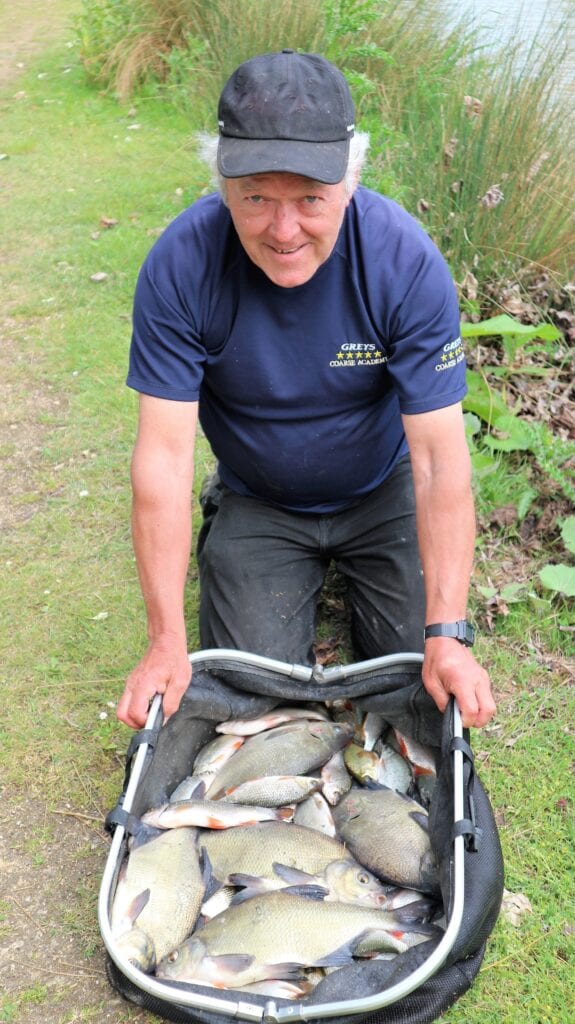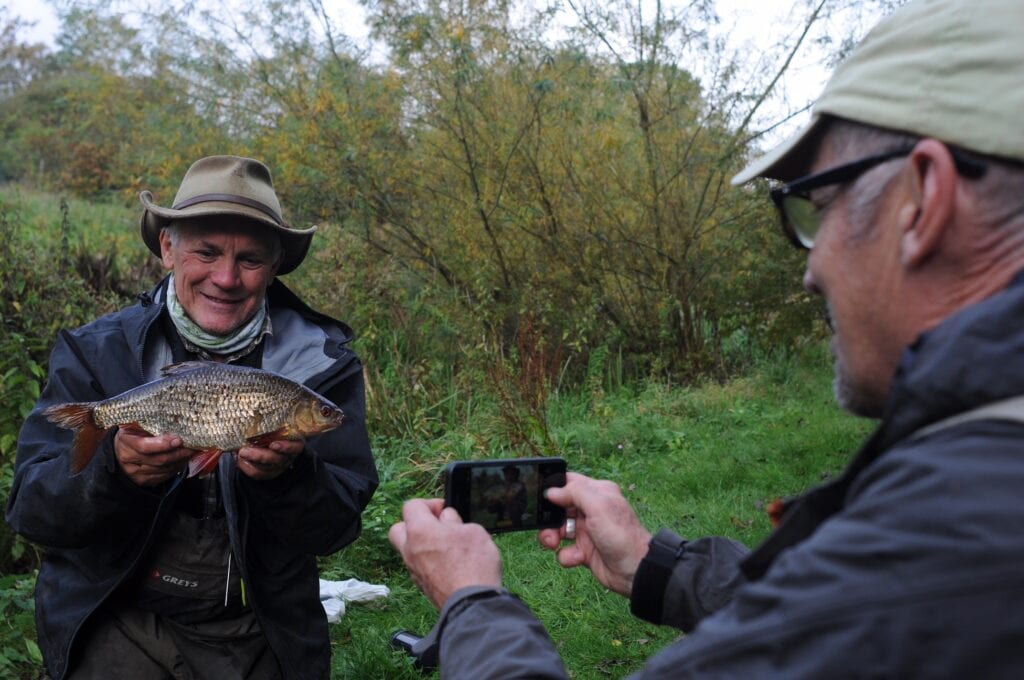Dave Coster – My Way with Bread
IN THE BEGINNING
My first proper acquaintance with bread as a viable bait was on the London canal match scene several decades ago, before squatts and bloodworm became widely used on towpath venues. Punched bread was often the first line of attack. Feeding small balls of crumb or liquidized gear at close range uncannily produced instant bites, mainly from small roach to begin with, but gradually bigger fish would move in. If the punch feed area dried up, we then used to explore further across the canal with different baits like maggots or casters. However, bread became so deadly, very often you could catch all day on it and didn’t need to move to another part of the swim. The only changes we made as sessions progressed, entailed experimenting with punch sizes to keep the bites coming, or switching to baits like hemp and tares if quality roach turned up. My cult Image Punch Board with its sliding lid, along with several treasured metal punch sets, became essential kit for many years.
FEED TYPES

All I used to do in my early bread punch days was feed brown crumb, but that began to change as some clever match anglers on the London circuit started to clean up using liquidized bread. The companies that made food blenders must have wondered where all the extra sales were coming from! But the only problem with liquidized feed was its lightness and reluctance to sink if there was any tow or flow. I know anglers these days use fish tank gravel to get their punch feed down fast, but back then things weren’t quite that technical. My compromise was to mix liquidized bread 50-50 with brown crumb, which worked well enough for me. Gradually, punched bread was overtaken by baits like squatts, bloodworms and jokers on my favourite canal venues, and my punch sets went into hibernation. I’ve only brought them back into play recently, since I have started fishing canals and drains again. It’s amazing the diversity of different punch crumb groundbaits you can buy now.
GOING BACK

Revisiting some of my old bread techniques, a top one is using the pole, accurately feeding balls of crumb in a large cup. I didn’t want to return to liquidizing again, with all the hassle of buying a food blender. Instead, I mix up several different types of punch groundbaits. This resulted in a nice fluffy feed, which looked perfect to combine with small pellets of white bread. As if I had never been away, my first punch session for at least twenty years produced bites straight away. Obviously, the fish hadn’t forgotten what bread looks like; it’s just us anglers who got carried away with trendy baits like pellets and fluorescent wafters! It took me a while to remember some of those good old bread tricks, like making punched hook baits sink slowly on a tight line, or suspending them just off bottom, so fish could find them more easily. Once the swim was buzzing, I also remembered to start feeding some hemp, which was always a great way of attracting any bigger roach in the area.
RIGGING RIGHT

Punch works brilliantly with pole tackle, but if you are not into this way of fishing don’t worry, there are a couple of equally good running-line tactics I will cover a bit later. The best way to rig up for the pole is to use streamlined floats with super-sensitive fibre tips and wire stems. The wire cocks the float quickly and cuts down the need for big shotting, instead allowing small spread bulks of micros. Two or three lightweight number 12 droppers are used below the bulk, the aim being to get a slow fall of a punched bread hook bait. This clever shotting can be spread out even more or bulked together to get the bait down faster, if required. As mentioned earlier, I often use a pole cup for extra accuracy, but happily switch to feeding balls of crumb by hand if I can get away with it, should regular groundbait be working at close range. One other important thing about my punch pole floats is I have replaced standard metal stems with titanium trace wire, which doesn’t bend out of shape.
SIZE MATTERS

When returning to bread fishing, I quickly remembered to experiment with punch sizes. Some might think smaller punches are for small fish, and then to simply step up in diameter to catch something bigger. But in the real world it’s a case of getting bites first. It’s amazing how experimenting with different size hook baits can make such a big difference in helping a float to go under. It obviously pays to try bigger punches for larger fish, but equally, a smaller punch will often bring bites back if they dry up. It’s worth noting that compressed bread expands in the water, close to twice its size. Due to this, I don’t mess around using the slot most brass-headed punches have in their sides. I simply push the hook point into the middle of a piece of punched bread, carefully making sure not to make contact with the metal head of the punch, before lifting the pellet of bread out. I then press the hook point against a finger to make sure it has gone properly through the bait.
STAMP ROACH

Roach this size are good weight builders in competitions and they absolutely love punched bread. This bait will often pull lots of action on frost-affected venues when other offerings can’t buy a bite. Bread has an uncanny knack of making something happen in clear water, and you know if it is going to work almost instantly. It’s cheap too. You only need a few slices from a medium-sliced white loaf, combined with around a kilo of prepared crumb groundbait. The type of venues where punch works well (with pole or whip tackle) are canals, drains, natural lakes and slow-moving rivers. Don’t ignore commercial fisheries either, once cold weather has slowed carp activity down and made the water less coloured. Many commercials hold good stocks of silver fish, which can provide great sport when conditions are hard. Some people swear by flavouring bread and crumb feed, but I don’t think this makes any difference. I reckon this is mainly a visual bait that fish feed on by second nature.
SUPER SEEDS

Cooked hemp is a brilliant backup feed to bread, and can even eventually replace punch on the hook. If you want to target bigger fish, simply feed hemp with your punch crumb from the start of a session. The seeds can be added to your groundbait, or loose fed over the top of it. Knowing when to switch to hemp on the hook is easy. Normally after catching small silvers initially on bread, sooner or later bigger fish shoulder their way in all the activity. When your landing net starts to come into play, you know it’s time to try hemp on the hook. If you get plenty of bites using hemp, you can usually stop feeding crumb altogether and simply rely on keeping small amounts of the seeds going into your swim regularly. The size of fish should improve dramatically, even more so if you try a larger tare on the hook. Cooked tares are softer and easier to push a hook into. These are a prime bait for roach, rudd, dace, chub and hybrids. River skimmers and barbel can be suckers for tares too.
ALL CHANGE

Suddenly a bread punch and hemp session can change into a different beast altogether when big roach come calling. Punch crumb in all its possible forms is a great swim activator. It doesn’t matter if it stirs up hoards of small fish first, because all the activity will help to wake up bigger samples. The trick is then to find out what they want on the hook. Sometimes larger roach will simply barge small stuff out of the way, so it doesn’t matter much what you give them. But big roach in particular are crafty creatures, often staying on the outskirts of what’s happening in your swim. That’s why it can pay to work your tackle around the edges of your feed area. You will be amazed at how this can pick off surprisingly better fish than you had been hooking. There’s a fine line between catching a few pounds of tiddlers and bagging up big time with much bigger red fins. That’s why its important to keep experimenting with different size bread hook baits, or switching completely to hemp and tares.
GOING LARGE

Punch fishing isn’t just a match technique. Over the years I have been privileged to meet some great river anglers who vary their bread approach considerably. The traditional way of mashing up loaves and feeding the resulting slop, trotting over the top with big bits of flake, still works wonders for many. But simply switching to much bigger bread punches can be just as good, also making life a bit easier. Bigger pellets of punched bread stay on the hook better, plus when they swell up in the water, do they really look that different to flake, especially when passing through at the speed of the current? I don’t think so. I have been lucky enough to catch many specimen-sized roach using big bread punches and trotting with meaty river floats. I used to do this in combination with liquidized bread and brown crumb groundbait, similar to the mix I once used on canals. But these days I can buy cheap ready-liquidized, freeze-dried bread in my local tackle shop, which is far more convenient.
WAGGLER ROUTE

As I mentioned earlier, punch fishing isn’t just a pole-orientated method. Apart from working well on flowing water with big sticks, loafers, chubbers and Avon floats, it can also be a top bait to use with running-line wagglers. For this I prefer peacock wagglers with fine inserts, floats I usually modify myself. I have changed the inserts on most of my favourite peacock wagglers to take varying diameters of hollow plastic tips. I find these don’t affect the floats when casting. Also, by using bright fluorescent paint directly onto the clear plastic, I get a great translucent effect I can see well under most conditions. Finer-tipped inserts help to let bites develop in a nicer way, without the fish feeling any undue resistance, which can make them reject the hook bait. With strung shotting down the rig, a thin insert reads better as the last couple of shot register on it, helping to show up on-the-drop bites. I use this type of float on wider drains and canals for big fish, over towards far bank features.
DEADLY CAGES IT

Yet another running-line method I like to use with punched bread revolves around small cage feeders, packed out with a good mixture of milky and fluffy crumb particles, which explode into an enticing cloud as they hit bottom. This is a top way of catching big roach in small to medium-sized rivers, also worth trying in various types of clear stillwaters. I normally use medium to large punches for this type of fishing, along with short 12-14inch hook lengths. The latter help to signal bites before fish can steal your bait, which tends to happen with longer links. A good reserve trick here is to use two pellets of punched bread on a slightly bigger hook, just in case one piece comes adrift. I also use shallow punches that really compress the bread hard. It helps if you flatten fresh slices with a roller and keep them stored in a plastic bag, so they sweat up a bit and turn slightly sticky. Similar to the previous bread tactics I’ve looked at, there’s no harm in adding some hemp to cage feeder mixes.
QUALITY COUNTS

Being a bit bolder with bread can bring some surprise hauls of decent-sized fish, particularly when there are skimmers to be caught. This species can be difficult to fool on both wild and commercial venues, having learnt how to mop up groundbait and any smaller particles of feed, while cleverly ignoring hook baits. But this doesn’t happen so easily if you fish punched bread over crumb feed with a pole, waggler or cage feeder. The fish get confused and mop up everything. It’s a bit like the way anglers on commercials have learnt how to clean up with groundbait paste, which presented over a bed of the same feed gets hoovered up by lots of different species, not just carp. This leads me on to another interesting thing I’ve discovered with bread. You don’t rigidly have to use it as hook bait over breadcrumb feed. It can work in conjunction with various other groundbait recipes. I find non-fishmeal mixes are best, especially ones aimed at silver fish species like roach and skimmers.
JB’s Way with Bread

A SLICE OF LIFE
The way that these “Our Ways” work, or don’t according to your view, is that Dave does his bit up front, and then I come along and plug in any gaps as I see them. With this particular subject I really am more in awe than normal. DC’s analysis of bread/bread punch highlights the difference between us clearly, perhaps the difference between top matchmen and the rest of us also-rans in general. In a match, time is of the essence and a minute lost is a minute wasted. Control. Precision. Nothing left to chance. This is what DC is about and it shines through his excellent piece. I had actually asked him to write about bread punch, almost as a favour to me. It was a method I flirted with in my long-distance youth and I had a nagging feeling it would serve me well again now. After reading DC’s words, that feeling is now a certainty.
Bread punch did feature in my childhood up in the North West. I watched it in use on the canals without ever quite picking up the basics… I was after all only six. My mates and I used it primarily at the Roman Lakes in Marple, just out of Stockport. A day ticket there at the turn of the Sixties was a lot, and after buying that, there wasn’t much left over for maggots. Bread was the answer but not a whole costly loaf. The guy in the cafe at Roman used to sell us bread by the slice, at an outrageous mark-up, and we found that we could spin each slice out by punching it rather than using it as flake. The roach there were crackers – longer than our floats, which was always our yardstick of a whopper. If the slice went stale in the sun, we also used to mix up a kind of paste, but neither that nor our version of punch were baits DC would swoon over.
CARP ON CRUST

Moving into adolescence, bread continued to feature high on my bait list, this time used as crust for the carp at Disney Dam, on the footsteps of the Peak District. Between 1963 when I joined and 1968, when my fishing was more exclusively in Norfolk, I landed 83 carp from the Dam, every single one caught on crust apart from my only ten pounder which came to worm. Looking back, whilst most of the carp caught were five pounds or less, the Dam taught me crust techniques I have never forgotten, and which put me in the driver’s seat to this day.
From 1969, I fancied myself as a specimen hunter proper, notwithstanding the fact that I hadn’t actually caught any specimens yet. The roach I found in Norfolk were on average five times bigger than Roman Lake roach and sometimes bigger than that. The Norfolk river experts I began to watch all used maggots or flake, and that was good enough for me. I got broken devastatingly a few times on maggots, size 18s and 2lb bottoms, so from then on, it was all flake, size 10s and 3lb or 4lb line straight through. That’s fifty years ago and I’m still stuck there in exactly the same place, unmoved for half a century. But then, why should I have changed? Those years and those tens of thousands of pieces of flake have caught me hundreds of roach to nearly four pounds, seventy chub over six pounds, and even big barbel, bream and dace.
FLAKE MUST BE FRESH

I cannot pretend that my way with flake is nearly as high-powered as DC’s way with punch, but I am neurotic about how my flake is hooked and presented. I insist that my loaf is off-the-shelf fresh. I forget all the good, healthy stuff and buy the cheapest, most plastic rubbish available. I am extremely fussy about pulling out a pristine piece of bread that is exactly the right size… a 5p coin for a size 10 hook. I would never trust anyone else’s baiting up because I know I do it better than anyone… and after a million bashes, so I should be good. I hold the hook at the eye between the thumb and first finger of my right hand. I push the bend of the hook through the middle of the flake, which I am holding between the thumb and first finger of my left hand. Holding that bend in my left, I then squeeze the flake around the eye and shank of the hook with my right, ensuring a good grip there. I leave a decent amount of the bread all nice and fluffy, away from the shank, and the bait is ready to go. If I am not 100% happy, well, I’ll redo the whole thing till I am. If the bread is fresh, I estimate that in most water conditions, the flake will remain intact for getting on for twenty minutes, getting softer and more enticing as it sits there.
For half a century, I have loose-fed either pieces of flake or bread mash or bread crumb. In the early Norfolk days, I relied on the former, but after I watched maestros like Gerry Swanton and Owen Wentworth down on the Wessex rivers, I stepped up the amount of loose feed and swung over to mash predominantly. I still like crumb however: a slightly stale loaf is perfect and I simply grind slices between my hands for a minute and feed it in. Bits float but most breaks up and sinks in a cloud of bits and pieces… how DC must be shuddering at the randomness of all this.
LIMITATIONS

So if my bread approach has worked for me over all these decades, why have I implored DC to get me/us back on the right bread punch track? Over the last few years, I have realised my approach has limitations. My flake worked well, providing I was fishing it on the deck, and that was how I cared to fish it for forty-plus seasons. It was especially killing used in conjunction with a butt indicator and fished in a river slack. Of late, however, I have moved away from ledgering at night to float fishing in the day, and trotted flake has issues. First, you only really get one run down with a piece of flake, so it is hard, cold-fingered work in the depths of winter. More importantly, you miss many bites on the float/flake combination, like you do using flake on a quiver tip. Chub are not a particular problem with their big mouths, but roach are.
The problem as I see it, through many years of watching roach of all sizes attack flake, is this. They tend to suck a piece of flake into their lips and then move off with it, gradually taking it fully in as they swim away. Very often even a two pound roach will cover a yard of water before the flake is properly in the mouth and a strike can be made. Very much of the time, if you strike when a float first goes down or a tip goes round, all you do is pull the flake from the between the roach’s lips. This has haunted me. I have used smaller pieces of flake on smaller (or bigger) hooks, of course. I have delayed and delayed the strike. I have wetted the flake till it is super-soft and nothing much has worked.
USE YOUR LOAF

Nowadays, I don’t night fish really, and I don’t want to stare at a bobbin. By and large, I want to catch my roach in the light, preferably on a float, with bread on the hook. I will continue to use flake on the hook, I know. I am an old dog but I will learn new tricks, and when I find myself missing bites, even one bite come to that, I will swing to the punch and I will follow DC’s advice, to the letter.
I’m aware there is more to be said about bread, and I have a lot to add about my use of crust. But that is a summer game primarily, and if DC and I still have your attention in a few months time, then read all about it here. In the meanwhile, both DC and I hope that this latest “Our Way” gives you something to chew on over during lockdown. Between us, DC and I have fished for several centuries it seems, and been successful in our own spheres. That does not mean to say we know it all – me especially – so let’s hear from you, if you have a moment to put us right!



